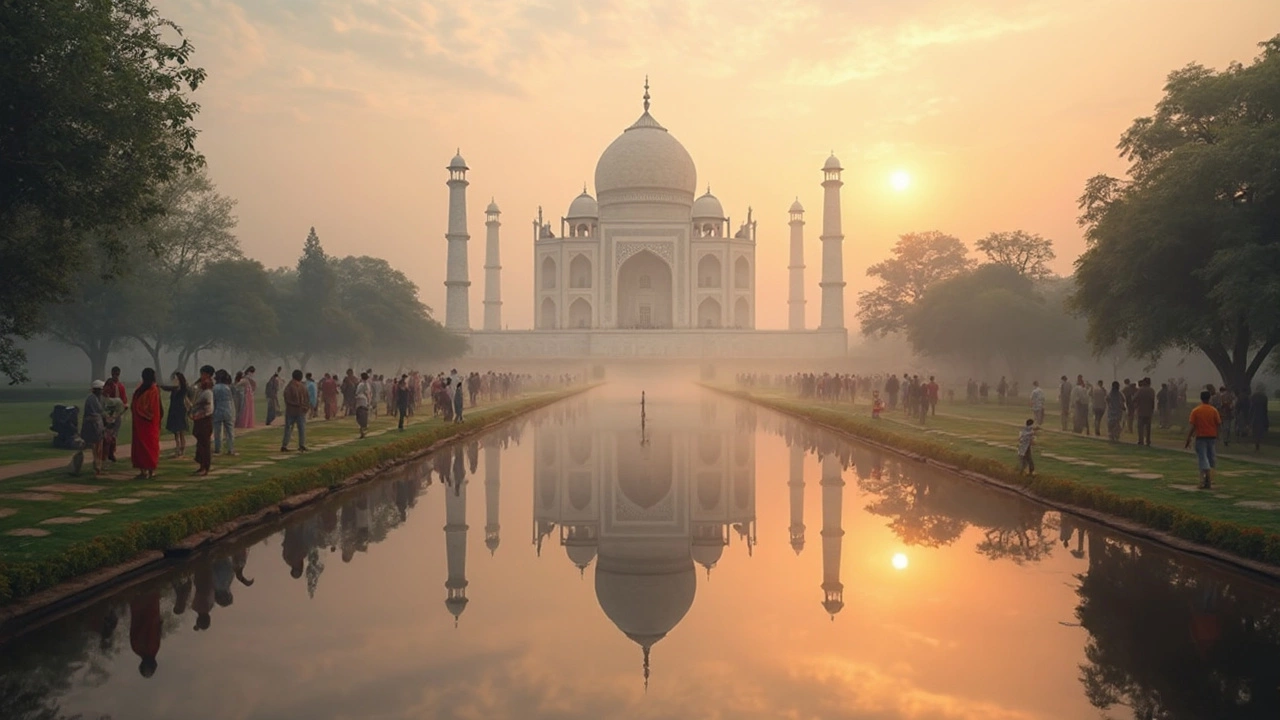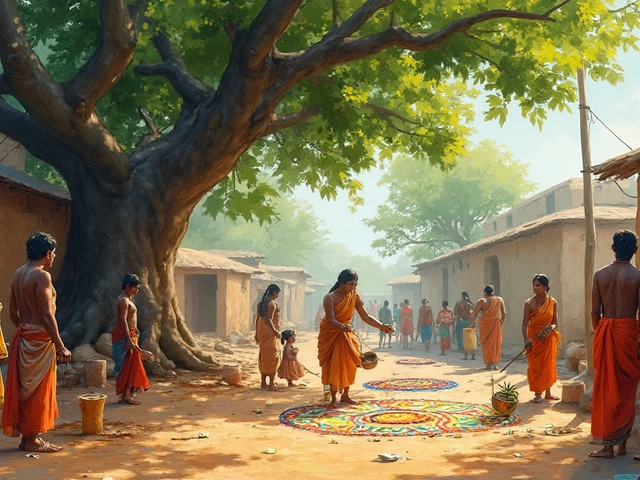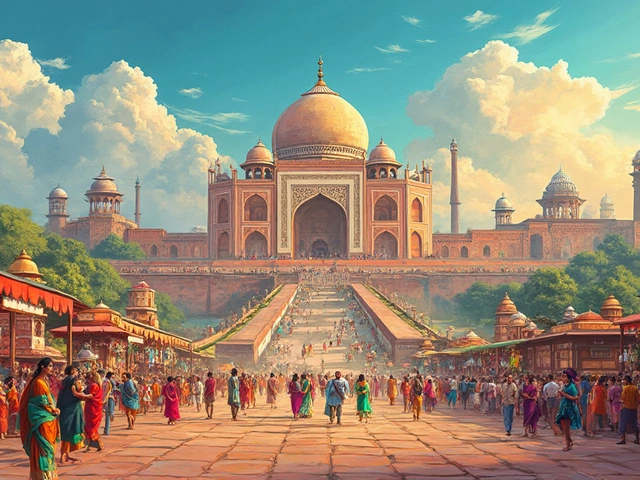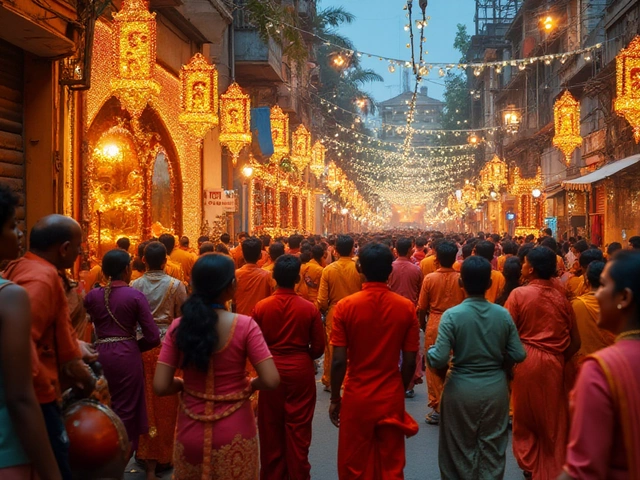If you ask people to picture the most beautiful monument on earth, the image that pops up almost every time is the Taj Mahal. This place isn’t just another stop on a tourist map—it’s like something out of a dream, but 100% real, just waiting in Agra, India, for anyone to walk up and see for themselves.
Millions travel from all over, most for that one perfect photo, but usually walk away realizing photos just can’t keep up. The Taj Mahal has this weird power: even if you know it from a zillion Instagram posts, standing there in person feels totally different. No filter, no fancy camera—just pure wow.
What makes it so special? It’s not just the white marble or that perfect symmetry. There are tons of little stories and clever tricks hidden in its design. Even serious architects from around the world keep studying it, just to figure out how it pulls off that mix of grand and peaceful at once.
- Why the Taj Mahal Stands Out
- Behind the Beauty: Stories and Facts
- Making the Most of Your Visit
- Other Indian Monuments Worth Seeing
Why the Taj Mahal Stands Out
The Taj Mahal isn’t just another famous building—it’s a piece of history built out of love. Shah Jahan, a Mughal emperor, had it built in the 1600s as a tomb for his wife Mumtaz Mahal. Talk about going all out for someone you care about. That’s part of why the story grabs people; the Taj isn’t about a king’s ego, it’s a monument set up because of heartbreak and devotion.
The details are on another level. The whole thing is carved from white marble that actually changes color with the time of day and the weather. In the morning, the marble is a soft pink, by afternoon it’s bright white, and during sunset, it can look golden or bluish. The “wow” effect isn’t just in your head—it’s the sun and the stone working together. Most buildings just sit there. This one seems alive.
It’s also perfectly symmetrical. Lay anything alongside the main dome: the four minarets, the gardens, the pool, even the calligraphy–everything mirrors itself. This wasn’t just done for looks. The design means the Taj looks the same from almost any angle. No matter where you stand, the views are jaw-dropping.
- Over 20,000 workers and 1,000 elephants built it. No kidding, elephants helped haul heavy stones from miles away.
- The marble was brought in from Makrana in Rajasthan, while gems and stones came from as far away as Sri Lanka, Tibet, and even parts of Central Asia.
- The garden layout follows the Persian "charbagh" style, which aims to show paradise on earth with four rivers and lush greenery.
There are tons of hidden tricks, too. The minarets are actually tilted outward a bit—if there was ever an earthquake, they’d fall away from the main dome so the central tomb stays safe. There’s also echo magic: stand at the entry, clap your hands, and sound bounces back in a way that’s hard to believe. The calligraphy looks perfect up close and at a distance, because the writing grows taller as it goes higher—basic trickery that just works.
The Taj Mahal manages to mix mind-blowing craftsmanship with a real story, and that keeps people coming—no matter how much hype it gets, it always pulls that "worth it" feeling out of visitors. If you’re picking the most beautiful spot in the world, this one’s always on the short list for a reason.
Behind the Beauty: Stories and Facts
The Taj Mahal isn’t just a pretty face—it’s basically a giant love letter built out of marble by Shah Jahan for his wife Mumtaz. He started building it back in 1632, and it took over 20 years to finish. That’s a legit commitment!
If you’re curious about what makes the Taj Mahal top every bucket list, here’s what stands out:
- The main dome is 73 meters high, which is taller than a 20-story building. You don’t notice it in photos, but in person it towers right over you.
- Over 20,000 workers and 1,000 elephants helped build this place. Yep—actual elephants, hauling massive marble slabs day and night.
- The white marble isn’t just for show. When the sun hits it at sunrise, sunset, and even under a full moon, the whole building changes color. Early risers and night owls both win here.
- There are mind-blowing details up close, like floral designs made with 28 types of precious stones inlaid into the marble. No paint—just gems like jade, turquoise, and sapphire.
- The gardens aren’t just for looking nice. They’re laid out in precise patterns, cooled by water channels, which made beating the summer heat easier centuries before air-conditioning.
Check out these numbers and facts in one spot:
| Fact | Number/Details |
|---|---|
| Year construction began | 1632 |
| Years to complete | 22 |
| Main dome height | 73 meters |
| Estimated workers | 20,000+ |
| Types of gemstones | 28 |
| Annual visitors | Over 7 million |
There’s also a lot of wild myths: some say Shah Jahan wanted to build a matching black marble Taj across the river, but there’s zero proof. What’s true is his devotion—you can see both graves (his and Mumtaz’s) right inside, still side by side. Try whispering in the echo chamber under the dome—the sound just bounces forever, which feels fitting for a place built for eternal love.

Making the Most of Your Visit
If you want to really enjoy the Taj Mahal and avoid hassles, timing is everything. Go as early as you can—the site opens at sunrise, and the light at that hour makes the white marble glow. You’ll dodge the biggest crowds and the Agra heat plus get clearer photos without people crowding the frame.
Wednesdays are usually less packed because there’s no local market nearby, and on Fridays, the Taj Mahal closes to tourists for prayers at the mosque (but that’s easy to forget and can mess up your plans!). Don’t bother driving up; cars aren’t allowed close to the entrance, so you’ll have to walk or hop on the battery-powered shuttle—save your energy for the monument.
- Bring water and a hat—Agra gets scorching almost year-round.
- Shoes off before stepping on the main platform. Or, pack a pair of socks, since the marble gets burning hot by noon.
- Tripods are banned. Selfie sticks are okay, but security might ask you about anything bigger.
- Plan for 2-3 hours for a relaxed look at everything. An official guide isn’t a bad idea—there are lots of weird details you’ll miss otherwise (like the optical tricks in the entry gate walls).
Want to know the best months for a visit? Go between October and March. The heat’s bearable and pollution’s down, which means clearer skies for your photos. Skip major Indian holidays—the crowds just get wild. Foggy mornings in December or January can hide the Taj for hours, so check the weather before you book.
| Visitor Info | Details |
|---|---|
| Opening Hours | Sunrise to sunset (Closed Fridays) |
| Best Time for Photos | Sunrise or late afternoon |
| Average Entry Fee (Indians/Foreigners) | ₹50/₹1100 |
| Official Guide Fee | ₹300-₹500 per group |
| Nearest Train Station | Agra Cantt (roughly 6 km away) |
Bring an ID—you’ll need it to book tickets. The lines for entry can get long, but you can buy tickets online and skip most of the wait. Security’s strict: food, big bags, or drones stay outside. If you want to see the Taj from a different angle, hit Mehtab Bagh across the river—great spot for sunset pics, and fewer tourists to fight for space with.
Other Indian Monuments Worth Seeing
The Taj Mahal gets most of the attention, but India is basically stacked with jaw-dropping monuments that tell their own stories. If you're looking to experience more, you won’t run out of options. Each place has its own vibe, history, and set of cool facts that stick with you even after you leave.
Here’s a quick guide to a few picks that travelers totally love:
- Qutub Minar, Delhi: This tower is older than the Taj—started in 1192, finished up in 1220. It stands 73 meters high. When you walk around it, you notice all the carvings in the stone—each marking centuries of history. It’s also a UNESCO World Heritage site, just like the Taj Mahal.
- Gateway of India, Mumbai: This giant archway faces the Arabian Sea and was built in 1924. It’s the spot where the last British troops left India, so it’s a huge piece of history. Early mornings are best if you want a photo without crowds.
- Hawa Mahal, Jaipur: This "Palace of Winds" looks like a pink honeycomb. It has 953 tiny windows—yep, someone actually counted. The windows let in cool air, keeping things comfortable even with Rajasthan's heat.
- Mysore Palace: South Indian royalty still live here, but parts are open to check out. The palace lights up with 97,000 bulbs every Sunday and during festivals. It draws about 6 million visitors a year.
How do these places stack up with the Taj Mahal when it comes to numbers? Here’s a quick compare:
| Monument | Year Built | Annual Visitors | Location |
|---|---|---|---|
| Taj Mahal | 1632-1653 | 8 million | Agra |
| Qutub Minar | 1192-1220 | 3.9 million | Delhi |
| Gateway of India | 1911-1924 | 4 million | Mumbai |
| Hawa Mahal | 1799 | 1.5 million | Jaipur |
| Mysore Palace | 1897-1912 | 6 million | Mysore |
Tips for checking out these sites:
- Try visiting early in the morning—less crowd, cooler temps.
- Buy tickets online where possible; it’ll save you a lot of waiting.
- Bring a water bottle—India can get hot, even inside monuments.
- Many sites have dress codes, so try to wear clothing that covers shoulders and knees.
- For spots like Mysore Palace and Qutub Minar, guided tours can help you spot details you’d probably miss otherwise.
If you’re planning a trip to see the Taj Mahal, adding in a few of these other stops makes the trip way richer. Each place adds another layer to the story of India’s past and present.





